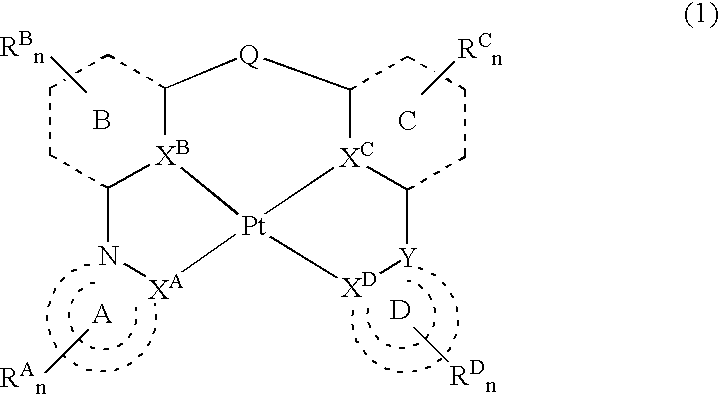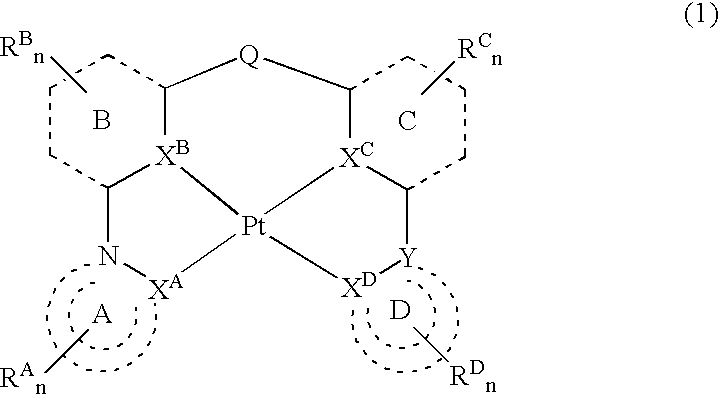Platinum complex and light-emitting device
a technology of complexes and light-emitting devices, applied in the direction of discharge tube luminescnet screens, cadmium organic compounds, group 3/13 element organic compounds, etc., can solve the problems of difficult to obtain phosphorescence emission from an organic compound at room temperature or higher, and it is difficult to synthesize derivatives used for improving luminous efficiency, and thermal stability. stability, superior in light-emitting characteristics and luminous efficiency
- Summary
- Abstract
- Description
- Claims
- Application Information
AI Technical Summary
Benefits of technology
Problems solved by technology
Method used
Image
Examples
reference example 1
Preparation of 1-(3-chlorophenyl)pyrazole
[0147]
[0148] A mixture of pyrazole (5.8 g, 84.8 mmol), potassium carbonate (15.6 g, 113.0 mmol), cuprous oxide (404 mg), salicylaldoxime (1.55 g), 3-chloroiodobenzene (7.0 mL, 56.5 mmol) and N,N-dimethylformamide (20 mL) was stirred under a nitrogen atmosphere at 95° C. for 16 hours. The reaction solution was allowed to cool to room temperature. Then water was added thereto and the mixture was extracted with toluene. The organic phases obtained were combined and concentrated. The residue obtained was purified by silica gel column chromatography, to give 1-(3-chlorophenyl)pyrazole as a pale yellow oily substance (7.6 g). Yield: 75.3%.
[0149]1H-NMR (200 MHz, CDCl3) δ: 6.48 (t, J=1.8 Hz, 1H), 7.25 (br d, J=8.0 Hz, 1H), 7.37 (t, J=8.0 Hz, 1H), 7.58 (br d, 8.0 Hz, 1H), 7.68-7.80 (m, 2H), and 7.91 (d, J=2.6 Hz, 1H).
example 1
Preparation of N,N-bis[3-(1-pyrazolyl)phenyl]aniline
[0150]
[0151] A mixture of aniline (232 μL, 2.55 mmol), 1-(3-chlorophenyl)pyrazole (1.0 g, 5.60 mmol), sodium t-butoxide (613 mg, 6.38 mmol), π-allylpalladium chloride (19 mg), di-t-butyl-(2,2-diphenyl-1-methylcyclopropyl)phosphine (72 mg) and toluene (10 mL) was stirred under a nitrogen atmosphere at 95° C. for 3 hours. The reaction solution was allowed to cool to room temperature. Then aqueous ammonium chloride-saturated solution was added thereto and the mixture was extracted with toluene. The organic phases obtained were combined and concentrated, and the residue obtained was purified by silica gel column chromatography and recrystallization, to give N,N-bis[3-(1-pyrazolyl)phenyl]aniline as a white powder (883 mg). Yield: 91.7%.
[0152]1H-NMR (200 MHz, CDCl3) δ: 6.41 (dd, J=2.0, 2.4 Hz, 2H), 6.96-7.22 (m, 6H), 7.24-7.40 (m, 5H), 7.42-7.50 (m, 2H), 7.67 (d, J=2.0 Hz, 2H), and 7.82 (d, J=2.4 Hz, 2H).
example 2
Preparation of Platinum Complex
[0153]
[0154] Platinum dichloride (211 mg, 0.795 mmol) and N,N-bis[3-(1-pyrazolyl)phenyl]aniline (300 mg, 0.795 mmol) were allowed to react in benzonitrile (20 mL) in reflux condition under nitrogen atmosphere for 3 hours. The solvent in the reaction solution was distilled off, and the residue obtained was purified by silica gel column chromatography and recrystallization, to give a platinum complex as yellow powder (114 mg). Yield: 25.1%.
[0155]1H-NMR (500 MHz, CD2Cl2) δ: 6.04 (dd, J=1.9, 7.4 Hz, 2H), 6.64 (dd, J=2.2, 2.6 Hz, 2H), 6.88-6.94 (m, 4H), 7.30 (dd, J=1.2, 8.4 Hz, 2H), 7.52 (t, J=7.4 Hz, 1H), 7.65 (dd, J=7.4, 9.0 Hz, 2H), 7.89 (dd, J=0.3, 2.1 Hz, 2H), and 8.10 (dd, J=0.3, 2.7 Hz, 2H).
[0156] Sublimation temperature: 262.5° C.
[0157] Thermal decomposition point: 383.94° C.
PUM
 Login to View More
Login to View More Abstract
Description
Claims
Application Information
 Login to View More
Login to View More - R&D
- Intellectual Property
- Life Sciences
- Materials
- Tech Scout
- Unparalleled Data Quality
- Higher Quality Content
- 60% Fewer Hallucinations
Browse by: Latest US Patents, China's latest patents, Technical Efficacy Thesaurus, Application Domain, Technology Topic, Popular Technical Reports.
© 2025 PatSnap. All rights reserved.Legal|Privacy policy|Modern Slavery Act Transparency Statement|Sitemap|About US| Contact US: help@patsnap.com



